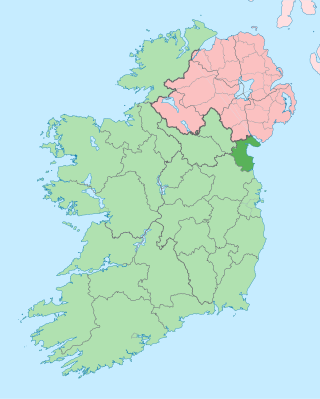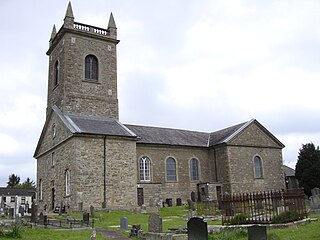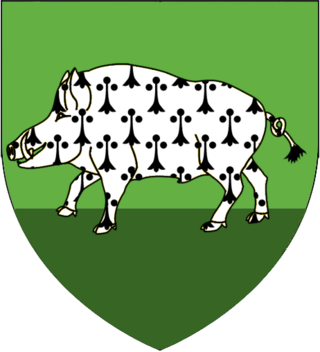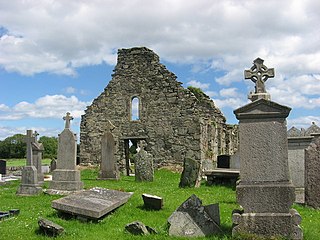
County Louth is a coastal county in the Eastern and Midland Region of Ireland, within the province of Leinster. Louth is bordered by the counties of Meath to the south, Monaghan to the west, Armagh to the north and Down to the north-east, across Carlingford Lough. It is the smallest county in Ireland by land area and the 17th most populous, with just over 139,100 residents as of 2022. The county is named after the village of Louth. Louth County Council is the local authority for the county.

Armagh is the county town of County Armagh and a city in Northern Ireland, as well as a civil parish. It is the ecclesiastical capital of Ireland – the seat of the Archbishops of Armagh, the Primates of All Ireland for both the Roman Catholic Church and the Church of Ireland. In ancient times, nearby Navan Fort was a pagan ceremonial site and one of the great royal capitals of Gaelic Ireland. Today, Armagh is home to two cathedrals and the Armagh Observatory, and is known for its Georgian architecture.

The Bishop of Clogher is an episcopal title which takes its name after the village of Clogher in County Tyrone, Northern Ireland. Following the Reformation, there are now parallel apostolic successions: one of the Church of Ireland and the other of the Roman Catholic Church.

Dunleer is a town and townland in County Louth, Ireland. Dunleer is situated midway between Dundalk and Drogheda and is located on the junction of the R132, R169 and R170 regional roads that intersect the town. As of the 2022 census, the town had a population of 2,143.

The Ó h-Anluain family was an agnatic extended family comprising one of a string of dynasts along the Ulster-Leinster border. Depending on the advantage to the clan, the Chief of the Name—The O'Hanlon—supported either the Earl of Tyrone or authorities within the English Pale. During the 15th century, ties were close with the famed Earls of Kildare. Frequently, members of the clan would fight on both sides during a rebellion. Some would be outlawed; others pardoned; some ending up on the winning side.

Dromiskin is a village and townland in County Louth, Ireland. It is situated 10 km south of Dundalk, about 1 km inland from the Irish coast. The village is in a civil parish of the same name.
Saint Mochta, was the last surviving disciple of Saint Patrick.

The Diocese of Armagh is the metropolitan diocese of the ecclesiastical province of Armagh, the Church of Ireland province that covers the northern half (approximately) of the island of Ireland. The diocese mainly covers counties Louth, Tyrone and Armagh, and parts of Down. The diocesan bishop is also the Archbishop of Armagh, the archbishop of the province, and the Primate of All Ireland. The Archbishop has his seat in St Patrick's Cathedral in the town of Armagh.

Togher is a large parish in County Louth, Ireland. A rural parish in the Roman Catholic Archdiocese of Armagh, Togher is situated approximately halfway between Drogheda and Dundalk.

Kilmovee is a village and civil parish in County Mayo, Ireland. It is a mainly rural parish on the R325 road, midway between Kilkelly and Ballaghaderreen.

Annagassan is a village in the townland of Ballynagassan, County Louth, Ireland. It sits where the River Glyde enters the Irish Sea. As of the 2022 census, Annagassan had a population of 189 people.
McCaul, also spelt MacCawell is an Irish surname, derived from the Gaelic Mac Cathmhaoil, meaning the "son of Cathmhaol", descendant of being implied. The name Cathmhaoil itself is derived from cath mhaol meaning "battle chief". The Mac Cathmhaoil were the leading family of Cenél Fearadhaigh, of the Uí Néill, and were based around Clogher in modern-day County Tyrone, Northern Ireland. They were one of the seven powerful septs that supported the O'Neills. Mac Cathmhaoil is now rare in Ulster as it has been Anglicised under various different forms such as, Campbell, McCawl, Caulfield, McCall, Alwell, Callwell, McCowell, Cowell, McCuill, Howell, MacHall, and McQuade.
The High Sheriff of Louth was the Crown's representative for County Louth, a territory known as his bailiwick. Selected from three nominated people, he held his office for the duration of a year. He had judicial, ceremonial and administrative functions and executed High Court Writs.

Drumcar House is a manor house in the historical parish of Drumcar in the barony of Ardee, 1 mile (1.6 km) northeast of Dunleer, County Louth, Leinster, Ireland. The house was built in 1777. It was home to the McClintock family from then to the 1940s, stemming from Alexander McClintock (1692–1775). One of its best known owners was John McClintock (1770–1855), a magistrate for County Louth, and formerly Serjeant at Arms in the Irish House of Commons, who was known to be occupying the estate in 1805 and until his death. The house was sold in about 1903 by The 2nd Baron Rathdonnell to his cousin, Frank McClintock (1853–1924), Rector of Drumcar and Dean of Armagh.

John McClintock was an Irish magistrate for County Louth, and formerly Serjeant at Arms in the Irish House of Commons.
Iarlaithe mac Treno was the Bishop of Armagh, Ireland from 468 to 11 February 481.

Saint Gobhan has long been linked with the parish of Seagoe – recorded for instance as Teach dho-Ghobha – in County Armagh, Ireland.

Port is a townland in the civil parish of Templeport, County Cavan, Ireland. It lies in the Roman Catholic parish of Templeport and barony of Tullyhaw.

St. Mochta's House is a medieval oratory and National Monument in County Louth, Ireland.
Francis George le Poer McClintock was Dean of Armagh from 1908 until his death.















